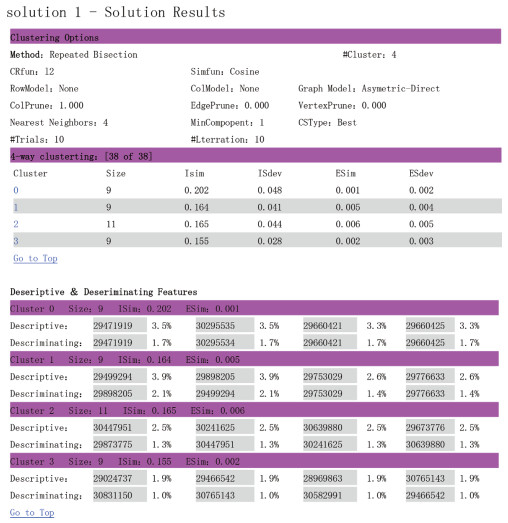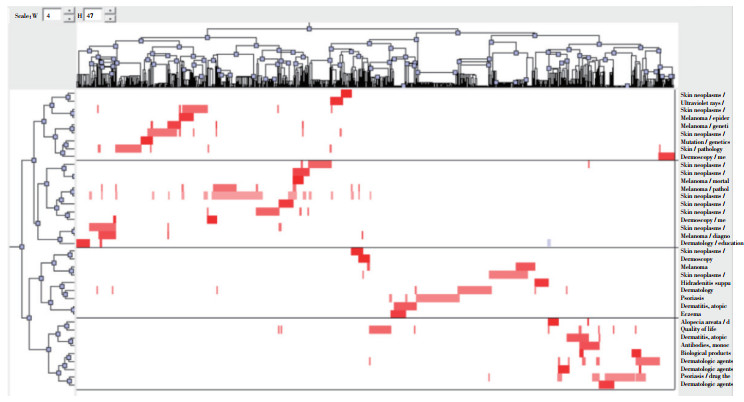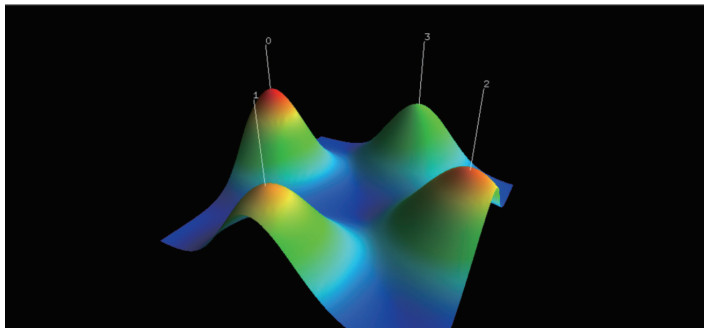文章信息
- 祝琳琳, 崔雷
- ZHU Linlin, CUI Lei
- 基于聚类分析方法的皮肤病学研究热点分析
- Cluster analysis for research hotspots in dermatology
- 中国医科大学学报, 2022, 51(1): 48-53
- Journal of China Medical University, 2022, 51(1): 48-53
-
文章历史
- 收稿日期:2020-12-25
- 网络出版时间:2021-12-27 20:39
2. 中国医科大学健康管理学院情报学教研室, 沈阳 110122
2. Department of Information Science, School of Health Management, China Medical University, Shenyang 110122, China
皮肤病学作为研究皮肤及其相关疾病的科学,其内容不仅涉及正常皮肤及附属器的结构和功能,还囊括了各种皮肤病及附属器官疾病的病因、发病机制、临床表现、诊断和防治等内容[1]。为了进一步了解此领域当前的研究热点,本研究采用皮肤病研究论文高频主题词进行共词聚类分析的方法,获得当前国际上皮肤病学的研究热点,为广大专业人员提供参考信息。
1 材料与方法 1.1 材料本研究分析材料来自PubMed数据库(https://www.ncbi.nlm.nih.gov/),该数据库由美国国立医学图书馆的国家生物技术信息中心开发维护。首先通过《期刊引用报告》(Journal Citation Reports,JCR)数据库(http://www.lib.wh.sdu.edu.cn/dn/database490.html)获取皮肤病学相关领域2018年影响因子最高的4种期刊:《JAMA Dermatology》 《Journal of the American Academy of Dermatology》 《The British journal of Dermatology》 《The Journal of investigative dermatology》。在PubMed数据库中检索4种期刊近2年发表的所有文献,检索策略为“JAMA Dermatology”[Journal] OR “Journal of the American Academy of Dermatology”[Journal] OR “The British journal of dermatology”[Journal] OR “The Journal of investigative dermatology”[Journal] AND “2018/01/01”[PDAT]:“2019/09/30”[PDAT]。并以XML格式下载文献记录。
1.2 方法对从PubMed获取的相关文献记录,应用书目共现分析系统(bibliographic item co-occurrence matrix builder,BICOMB)2.0进行数据提取与统计,统计字段为主要主题词/副主题词,两两统计它们在同一篇论文中出现的次数,并截取出现频次 > 15次者为高频词,从而形成主要主题词/副主题词-来源文献矩阵。2个主要主题词/副主题词在众多的文章中同时出现的频率越高,说明它们之间关系越密切。以TXT格式输入至gCLUTO软件中进行系统聚类分析,通过分析不同聚类类别主要主题词/副主题词,以及各个类别相对应的代表性文献,获得目前皮肤病学领域的研究热点。
将主要主题词/副主题词应用BICOMB生成主要主题词/副主题词相关文献词篇矩阵。
2 结果 2.1 皮肤病研究高频主题词共检索出相关文献5 136篇,截取出现频次 > 15次的38个主要主题词/副主题词形成高频词表[2-3],见表 1。相关文献词篇矩阵每一类中的主题词以及代表性论文见表 2。
| No. | Major subject headings /sub-heading | Frequency | No. | Major subject headings /sub-heading | Frequency | |
| 1 | Skin neoplasms/pathology | 117 | 20 | Skin neoplasms/mortality | 24 | |
| 2 | Psoriasis/drug therapy | 74 | 21 | Melanoma/genetics | 23 | |
| 3 | Psoriasis | 69 | 22 | Dermatology/methods | 23 | |
| 4 | Skin neoplasms | 58 | 23 | Eczema | 22 | |
| 5 | Dermatology | 57 | 24 | Dermatologic agents/administration & dosage | 22 | |
| 6 | Skin neoplasms/genetics | 50 | 25 | Melanoma/epidemiology | 21 | |
| 7 | Dermatologic agents/therapeutic use | 47 | 26 | Dermatology/education | 21 | |
| 8 | Melanoma/pathology | 46 | 27 | Skin neoplasms/therapy | 21 | |
| 9 | Skin/pathology | 46 | 28 | Hidradenitis suppurativa | 20 | |
| 10 | Quality of life | 42 | 29 | Biological products/therapeutic use | 18 | |
| 11 | Skin neoplasms/epidemiology | 42 | 30 | Ultraviolet rays/adverse effects | 18 | |
| 12 | Skin neoplasms/diagnosis | 42 | 31 | Dermatologic agents/adverse effects | 18 | |
| 13 | Skin neoplasms/surgery | 38 | 32 | Skin neoplasms/diagnostic imaging | 17 | |
| 14 | Skin neoplasms/drug therapy | 37 | 33 | Dermoscopy/methods | 17 | |
| 15 | Dermatitis,atopic | 33 | 34 | Mutation/genetics | 17 | |
| 16 | Dermatitis,atopic/drug therapy | 32 | 35 | Alopecia areata/drug therapy | 16 | |
| 17 | Melanoma | 31 | 36 | Dermoscopy | 16 | |
| 18 | Antibodies,monoclonal/therapeutic use | 29 | 37 | Melanoma/mortality | 15 | |
| 19 | Melanoma/diagnosis | 27 | 38 | Skin neoplasms/prevention & control | 15 |
| Category | Clustering results of high frequency words | PubMed ID of source literature | Number |
| Cluster 0 | |||
| Alopecia areata/drug therapy | 35 | ||
| Quality of life | 10 | ||
| Dermatitis,atopic/drug therapy | 29471919 | 16 | |
| Antibodies,monoclonal/therapeutic use | 30296535 | 18 | |
| Biological products/therapeutic use | 29660421 | 29 | |
| Dermatologic agents/therapeutic use | 29660425 | 7 | |
| Dermatologic agents/adverse effects | 31 | ||
| Psoriasis/drug therapy | 2 | ||
| Dermatologic agents/administration & dosage | 24 | ||
| Cluster 1 | |||
| Skin neoplasms/prevention & control | 38 | ||
| Ultraviolet rays/adverse effects | 30 | ||
| Skin neoplasms/epidemiology | 29499294 | 11 | |
| Melanoma/epidemiology | 29898205 | 25 | |
| Melanoma/genetics | 29753029 | 21 | |
| Skin neoplasms/genetics | 29775633 | 6 | |
| Mutation/genetics | 34 | ||
| Skin/pathology | 9 | ||
| Dermatology/methods | 22 | ||
| Cluster 2 | |||
| Skin neoplasms/drug therapy | 14 | ||
| Skin neoplasms/mortality | 20 | ||
| Melanoma/mortality | 37 | ||
| Melanoma/pathology | 30447951 | 8 | |
| Skin neoplasms/pathology | 30241625 | 1 | |
| Skin neoplasms/therapy | 30639880 | 27 | |
| Skin neoplasms/surgery | 29673775 | 13 | |
| Dermoscopy/methods | 33 | ||
| Skin neoplasms/diagnosis | 12 | ||
| Melanoma/diagnosis | 19 | ||
| Dermatology/education | 26 | ||
| Cluster 3 | |||
| Skin neoplasms/diagnostic imaging | 32 | ||
| Dermoscopy | 36 | ||
| Melanoma | 29024374 | 17 | |
| Skin neoplasms | 29466542 | 4 | |
| Hidradenitis suppurativa | 28969863 | 28 | |
| Dermatology | 30765143 | 5 | |
| Psoriasis | 3 | ||
| Dermatitis,atopic | 15 | ||
| Eczema | 23 |
2.2 高频主题词聚类分析结果
应用gCLUTO软件进行系统聚类分析,得到高频词的聚类结果(图 1)、高频词聚类的可视化矩阵(图 2)及高频词聚类可视化山丘图(图 3)。可视化矩阵(图 2)中,纵轴表示高被引论文,横轴表示这些论文之间的距离。图 3可视化山丘图中,数据矩阵被聚成4类,可视化山丘将4个类群显示为4个山丘。山丘的高度与类内相似性成正比,体积与类群包含的对象数量成正比。合成的高斯曲线相加在一起形成可视化山丘的地形。山丘的颜色与类内偏差成比例,红色代表变异低,蓝色代表变异度高。

|
| 图 1 高频词聚类结果 Fig.1 Clustering results of high frequency words |

|
| 图 2 高频词聚类的可视化矩阵 Fig.2 Visual matrix of high frequency word clustering |

|
| 图 3 高频词聚类的可视化山丘图 Fig.3 Visual hill map of high frequency word clustering |
3 讨论
通过高频词聚类结果(图 1)、高频词聚类的可视化矩阵(图 2)以及高频词聚类的可视化山丘图(图 3)发现,将所得数据聚成4类后,聚类效果较好,通过阅读各个类别对应的描述度较高的来源文献进一步了解每类的内容,将皮肤病学领域的研究热点主要分为4类。
第一类为皮肤病的药物治疗、疗效评价及安全情况的研究。对Cluster 0中相关代表性文献及类标签文献的分析结果显示,高频主题词主要聚集于皮肤科药物治疗,尤其是特应性皮炎(atopic dermatitis,AD)和慢性银屑病生物制剂治疗的效果、安全性,该类研究[4-7]对指导临床工作有实际意义。AD是一种复杂的慢性炎症性疾病,中重度AD在治疗上存在挑战。Dupilumab治疗中重度AD在疗效及耐受性方面值得被肯定[8]。目前针对AD的其他生物制剂也在临床研发中,如Tralokinumab(白细胞介素-13)及Nemolizumab(白细胞介素-31受体)等[9],这些研究为未来拓宽AD的治疗提供了新的前景。银屑病是一种常见的慢性免疫介导的炎症性疾病,严重影响患者的社会心理和情感健康,重症银屑病的患者通常接受光疗、全身性药物治疗(甲氨蝶呤、环孢菌素b、阿维A等)和生物制剂治疗等。
第二类为黑色素瘤的遗传学、流行病学等方面的研究。对Cluster 1中的相关高被引文献进行分析,4篇代表性文献[10-13]均是基于对黑色素瘤的研究,如突变对黑色素瘤的影响以及使用遗传学方法进行黑色素瘤风险预测。通过全基因组关联研究,已经鉴定出与黑色素瘤相关的单核苷酸多态性(single nucleotide polymorphisms,SNP)。然而,这些SNP对黑色素瘤发展的综合影响仍不清楚。与良性痣相比,黑色素瘤的BRAF突变率较低,这与BRAF突变可能是导致黑色素细胞增殖而不是恶性转化的基因概念是一致的[13]。
第三类为黑色素瘤的危险因素、回归预后、生存率和死亡率等方面的研究。对Cluster 2中相关高被引文献及类标签文献的分析结果显示,黑色素瘤多为黑色素细胞恶变而来的肿瘤,恶性程度高,对黑色素瘤患者的生存预后分析具有十分重要的临床意义[14-17]。经典的因素(厚度、溃疡、年龄)均对预后有影响[14]。皮肤痣数量增多显著增加了黑素瘤死亡的风险。痣的数目在临床实践中可能作为预测黑素瘤死亡风险的独立预后因素。
第四类为人乳头瘤病毒与皮肤肿瘤的关系及皮肤肿瘤的影像学诊断方面的研究。主要包括识别临床和皮肤镜特征,组织病理学诊断皮肤肿瘤,评估恶性肿瘤的风险[18-21]。皮肤镜检查被认为是检测黑色素瘤的重要工具,在临床上发现黑色素瘤之前就可揭示出它的不对称性,帮助临床医生更早地识别黑色素瘤。
综上所述,本研究通过共词聚类分析方法,分析了当前皮肤病学领域的研究热点。目前皮肤病学的研究热点主要集中在以下3个方向:(1)对各种生物制剂治疗皮肤病的效果评价安全情况;(2)对黑色素瘤的遗传学、危险因素、流行病学、生存预后、发病率与死亡率等方面的研究;(3)应用皮肤镜等影像技术诊断皮肤肿瘤,评估恶性皮肤肿瘤的风险。本研究结果为把握皮肤病学的研究现状和发展趋势奠定了基础,为临床工作和未来的研究提供了方向。
| [1] |
徐金华, 刘孟国. 中国皮肤病学研究现状与展望[J]. 中华医学信息导报, 2017, 32(1): 13. |
| [2] |
周永称, 崔雷. 文本挖掘在基因组注释中的应用[J]. 中华医学图书情报杂志, 2017, 26(3): 15-19. DOI:10.3969/j.issn.1671-3982.2017.03.004 |
| [3] |
史航, 高雯珺, 崔雷. 生物医学文本挖掘研究热点分析[J]. 中华医学图书情报杂志, 2016, 25(2): 27-33. DOI:10.3969/j.issn.1671-3982.2016.02.006 |
| [4] |
GOODERHAM MJ, HONG HC, ESHTIAGHI P, et al. Dupilumab: a review of its use in the treatment of atopic dermatitis[J]. J Am Acad Dermatol, 2018, 78(3 suppl): S28-S36. DOI:10.1016/j.jaad.2017.12.022 |
| [5] |
SEGER EW, WECHTER T, STROWD L, et al. Relative efficacy of systemic treatments for atopic dermatitis[J]. J Am Acad Dermatol, 2019, 80(2): 411-416.e4. DOI:10.1016/j.jaad.2018.09.053 |
| [6] |
GOTTLIEB AB, BLAUVELT A, THAÇI D, et al. Certolizumab pegol for the treatment of chronic plaque psoriasis: results through 48 weeks from 2 phase 3, multicenter, randomized, double-blinded, placebo-controlled studies (CIMPASI-1 and CIMPASI-2)[J]. J Am Acad Dermatol, 2018, 79(2): 302-314.e6. DOI:10.1016/j.jaad.2018.04.012 |
| [7] |
LEBWOHL M, BLAUVELT A, PAUL C, et al. Certolizumab pegol for the treatment of chronic plaque psoriasis: results through 48 weeks of a phase 3, multicenter, randomized, double-blind, etanercept- and placebo-controlled study (CIMPACT)[J]. J Am Acad Dermatol, 2018, 79(2): 266-276.e5. DOI:10.1016/j.jaad.2018.04.013 |
| [8] |
SIMPSON EL, BIEBER T, GUTTMAN-YASSKY E, et al. Two phase 3 trials of dupilumab versus placebo in atopic dermatitis[J]. N Engl J Med, 2016, 375(24): 2335-2348. DOI:10.1056/nejmoa1610020 |
| [9] |
WOLLENBERG A, HOWELL MD, GUTTMAN-YASSKY E, et al. Treatment of atopic dermatitis with tralokinumab, an anti-IL-13 MAb[J]. J Allergy Clin Immunol, 2019, 143(1): 135-141. DOI:10.1016/j.jaci.2018.05.029 |
| [10] |
CHO HG, RANSOHOFF KJ, YANG L, et al. Melanoma risk prediction using a multilocus genetic risk score in the women's health initiative cohort[J]. J Am Acad Dermatol, 2018, 79(1): 36-41.e10. DOI:10.1016/j.jaad.2018.02.052 |
| [11] |
WENDT J, MUELLER C, RAUSCHER S, et al. Contributions by MC1R variants to melanoma risk in males and females[J]. JAMA Dermatol, 2018, 154(7): 789-795. DOI:10.1001/jamadermatol.2018.1252 |
| [12] |
THOMAS NE, EDMISTON SN, ORLOW I, et al. Inherited genetic variants associated with melanoma BRAF/NRAS subtypes[J]. J Invest Dermatol, 2018, 138(11): 2398-2404. DOI:10.1016/j.jid.2018.04.025 |
| [13] |
SEITZ-ALGHROUZ R, HIDALGO JV, KAYSER C, et al. BRAF V600E mutations in nevi and melanocytic tumors of uncertain malignant potential[J]. J Invest Dermatol, 2018, 138(11): 2489-2491. DOI:10.1016/j.jid.2018.04.035 |
| [14] |
RIBERO S, GALLI F, OSELLA-ABATE S, et al. Prognostic impact of regression in patients with primary cutaneous melanoma >1 mm in thickness[J]. J Am Acad Dermatol, 2019, 80(1): 99-105.e5. DOI:10.1016/j.jaad.2018.06.054 |
| [15] |
WEE E, WOLFE R, MCLEAN C, et al. Clinically amelanotic or hypomelanotic melanoma: anatomic distribution, risk factors, and survival[J]. J Am Acad Dermatol, 2018, 79(4): 645-651.e4. DOI:10.1016/j.jaad.2018.04.045 |
| [16] |
LI WQ, CHO E, WEINSTOCK MA, et al. Cutaneous nevi and risk of melanoma death in women and men: a prospective study[J]. J Am Acad Dermatol, 2019, 80(5): 1284-1291. DOI:10.1016/j.jaad.2018.12.058 |
| [17] |
VON SCHUCKMANN LA, HUGHES MCB, LEE R, et al. Survival of patients with early invasive melanoma down-staged under the new eighth edition of the American Joint Committee on Cancer staging system[J]. J Am Acad Dermatol, 2019, 80(1): 272-274. DOI:10.1016/j.jaad.2018.04.017 |
| [18] |
BOUWES BAVINCK JN, FELTKAMP MCW, GREEN AC, et al. Human papillomavirus and posttransplantation cutaneous squamous cell carcinoma: a multicenter, prospective cohort study[J]. Am J Transplant, 2018, 18(5): 1220-1230. DOI:10.1111/ajt.14537 |
| [19] |
BZHALAVA D, MÜHR LS, LAGHEDEN C, et al. Deep sequencing extends the diversity of human papillomaviruses in human skin[J]. Sci Rep, 2014, 4: 5807. DOI:10.1038/srep05807 |
| [20] |
ARROYO MÜHR LS, HULTIN E, BZHALAVA D, et al. Human papillomavirus type 197 is commonly present in skin tumors[J]. Int J Cancer, 2015, 136(11): 2546-2555. DOI:10.1002/ijc.29325 |
| [21] |
ANTONSSON A, WATERBOER T, BOUWES BAVINCK JN, et al. Longitudinal study of seroprevalence and serostability of 34 human papillomavirus types in European organ transplant recipients[J]. Virology, 2013, 436(1): 91-99. DOI:10.1016/j.virol.2012.10.037 |
 2022, Vol. 51
2022, Vol. 51




